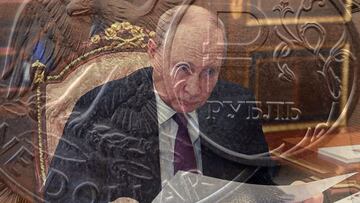What are the consequences if Russia does not pay its bonds on time?
Heavy sanctions have been placed on Russia following their invasion of Ukraine, and with assets frozen, questions over Putin's repay ability are raised.

Whether or not President Vladimir Putin planned for it - and let's be honest, his unlawful invasion of Ukraine has not gone according to his strategic plan - the United States and its allies have imposed crippling sanctions on Russia, increasing as the humanitarian crisis and wider threat has escalated.
One of the questions raised as Russia’s central bank assets were frozen and the ruble, the national currency, saw its value plummet, is what would happen if the country was unable, or refused, to pay back its debt.
More on the Russia-Ukraine conflict:
- What has happened to the residents of Mariupol?
- What has Biden said about Putin's sanctions on the US?
- NASA release stark image of Ukraine from space
- REPO multilateral task force sets out to track down Russian assets
What does Russia owe?
Russia is due to make another dollar-denominated payment to bondholders on Monday after last week defying fears it might not be able or willing to do so, following Western countries' unprecedented sanctions over Moscow's actions in Ukraine.
Paying external holders last week means Russia swerved its first default, for now, since a 1998 financial crisis and its first on international bonds since the 1917 revolution, when the Bolsheviks repudiated obligations of the Tsarist government.
But with Russia due to repay another $66 million on Monday and a total of $4.7 billion between now and year end, there are further tests to come.
The unprecedented sanctions and export controls the U.S. and over 30 countries have imposed on Russia are taking their toll.
— The White House (@WhiteHouse) March 11, 2022
Today:
-The ruble is worth less than a penny
-The Russian stock market is closed for the longest time ever
-Russia’s credit rating is now “junk” status
The background to Russia's payments
Russia has 15 international bonds outstanding with a face value of around $40 billion. Prior to the Ukraine crisis roughly $20 billion was held by investment funds and money managers outside Russia. Last week's drama centred on two bonds the government issued in 2013, for which coupon, or interest, payments with a combined value of just over $117 million were due on Wednesday. Like many international bonds there was a 30-day grace period, meaning Moscow effectively had until 15 April to pay.
Initially, Russia seemed to balk at the prospect of sending scarce hard currency overseas, but on 14 March the finance ministry said had approved a temporary procedure to make the payments.
Under a temporary license issued by the U.S. Office of Foreign Assets Control (OFAC), Russia's correspondent bank JPMorgan, was able to process the cash before crediting it to another U.S. bank, Citigroup, the paying agent. Citi checked the details and distributed it to bondholders, who market sources said on Thursday and Friday had received the money.
When and what is the next credit test?
Further tests come thick and fast. On Monday, Russia is due to make a $66 million payment although technically, under the terms of the issue it could make this payment - as well as a $102 million one on 28 March - in alternatives currencies, including rubles.
Gramercy, an emerging markets fund manager, noted on Friday that making use of the bond's "alternative payment currency event" required a 15-day notice, which it said Russia's finance ministry had not published.
After last week's payment showed Russia had the ability and willingness to pay in dollars, Morgan Stanley analysts said there was no reason for Russia to be able to invoke the alternative ruble payment clause, but that "doesn't guarantee that Russia won't try".
On 31 March there is a $447 million payment that must be made in dollars, while its biggest payment of the year -- and its first full repayment of "principal", of $2 billion -- is due on 4 April.
Foreign investors also owned about $38 billion-worth of ruble-denominated sovereign bonds known as OFZs before this crisis, JPMorgan estimates -- nearly 20% of that market. Some of the payments due on those have not yet been made.
Russia may be on the brink of its first default on international debts in more than a century https://t.co/JC7Beb2qCu pic.twitter.com/SsluXZPO25
— Reuters (@Reuters) March 17, 2022
Is Russia able to continue paying?
Even if Russia remains willing to pay, there may be complications, especially for bonds that must be serviced in dollars.
Western sanctions ban transactions with Russia's finance ministry, central bank or national wealth fund, although the temporary general license 9A issued by OFAC on 2 March makes an exception for the purposes of "the receipt of interest, dividend, or maturity payments in connection with debt or equity". That license expires on 25 May, however, after which Russia will still have almost $2 billion worth of external sovereign bond payments to make before the end of the year.
Morgan Stanley analysts say that after Monday's test, the next crucial date is 27 May, when the first payments come due after the licence has expired. That could force Russia into making payments for a dollar 2026 bond and a euro 2036 bond in rubles to onshore accounts, which the finance ministry has said would be its fallback option. That would trigger a default on the dollar bond, as only the euro bond allows for payment in rubles.
Morgan Stanley analysts say that the GL9A licence could be extended, "yet for this to happen it would need a significant move towards de-escalation".
Some analysts suggest money frozen abroad under the sanctions may have been used for last week's payments, although Russia has generally paid debt out of budget funds in the past.
What happens if Russia doesn't pay its debt?
If Russia fails to make any of its bond payments within their defined grace periods, or pays in rubles where dollars or euros are specified, it will be a historic default. Such an event would have been unthinkable before the 24 February invasion of Ukraine, which Moscow describes as a "special military operation", and subsequent Western sanctions.
Related stories
Russia has nearly $650 billion of central bank reserves, one of the lowest debt-to-GDP levels in the world and has been raking in money from soaring oil and gas prices.
A default would lock it out of the international borrowing markets until the sanctions were lifted and it repaid creditors for any losses they had suffered. It would also depress its credit ratings for some time, pushing up the interest rates the government and big Russian companies can borrow at.

